|
1 |
Drug-susceptible tuberculosis |
0.385 |
0.318 |
0.522 |
0.444 |
|
2 |
Multidrug-resistant tuberculosis without extensive drug resistance |
0.651 |
0.434 |
0.632 |
0.504 |
|
3 |
Extensively drug-resistant tuberculosis |
0.682 |
0.453 |
0.672 |
0.529 |
|
4 |
Latent tuberculosis infection |
0.218 |
0.268 |
0.212 |
0.324 |
|
5 |
Drug-susceptible HIV/AIDS - tuberculosis |
0.715 |
0.474 |
0.669 |
0.527 |
|
6 |
Multidrug-resistant HIV/AIDS - tuberculosis without extensive drug resistance |
0.784 |
0.529 |
0.850 |
0.688 |
|
7 |
Extensively drug-resistant HIV/AIDS - tuberculosis |
0.783 |
0.527 |
0.803 |
0.636 |
|
8 |
HIV/AIDS resulting in other diseases |
0.756 |
0.505 |
0.791 |
0.624 |
|
9 |
Diarrhoeal diseases |
0.179 |
0.258 |
0.246 |
0.335 |
|
10 |
Typhoid fever |
0.325 |
0.299 |
0.310 |
0.356 |
|
11 |
Paratyphoid fever |
0.376 |
0.315 |
0.438 |
0.406 |
|
12 |
Other intestinal infectious diseases |
0.266 |
0.281 |
0.420 |
0.398 |
|
13 |
Lower respiratory infections |
0.387 |
0.319 |
0.420 |
0.398 |
|
14 |
Upper respiratory infections |
0.159 |
0.253 |
0.286 |
0.348 |
|
15 |
Otitis media |
0.169 |
0.256 |
0.137 |
0.302 |
|
16 |
Pneumococcal meningitis |
0.606 |
0.410 |
0.518 |
0.442 |
|
17 |
H influenzae type B meningitis |
0.613 |
0.413 |
0.551 |
0.458 |
|
18 |
Meningococcal infection |
0.554 |
0.385 |
0.544 |
0.455 |
|
19 |
Other meningitis |
0.583 |
0.398 |
0.651 |
0.516 |
|
20 |
Encephalitis |
0.693 |
0.460 |
0.673 |
0.529 |
|
21 |
Diphtheria |
0.348 |
0.306 |
0.468 |
0.418 |
|
22 |
Whooping cough |
0.339 |
0.303 |
0.279 |
0.346 |
|
23 |
Tetanus |
0.506 |
0.364 |
0.570 |
0.468 |
|
24 |
Measles |
0.321 |
0.298 |
0.320 |
0.360 |
|
25 |
Varicella and herpes zoster |
0.262 |
0.280 |
0.403 |
0.391 |
|
26 |
Malaria |
0.420 |
0.331 |
0.467 |
0.418 |
|
27 |
Chagas disease |
0.575 |
0.394 |
0.604 |
0.487 |
|
28 |
Visceral leishmaniasis |
0.424 |
0.332 |
0.520 |
0.443 |
|
29 |
Cutaneous and mucocutaneous leishmaniasis |
0.373 |
0.315 |
0.466 |
0.418 |
|
30 |
African trypanosomiasis |
0.490 |
0.357 |
0.511 |
0.438 |
|
31 |
Schistosomiasis |
0.383 |
0.318 |
0.421 |
0.399 |
|
32 |
Cysticercosis |
0.417 |
0.329 |
0.558 |
0.462 |
|
33 |
Cystic echinococcosis |
0.404 |
0.325 |
0.506 |
0.436 |
|
34 |
Lymphatic filariasis |
0.492 |
0.358 |
0.588 |
0.478 |
|
35 |
Onchocerciasis |
0.275 |
0.284 |
0.429 |
0.402 |
|
36 |
Trachoma |
0.376 |
0.316 |
0.556 |
0.461 |
|
37 |
Dengue |
0.395 |
0.322 |
0.461 |
0.416 |
|
38 |
Yellow fever |
0.512 |
0.366 |
0.463 |
0.416 |
|
39 |
Rabies |
0.685 |
0.455 |
0.656 |
0.518 |
|
40 |
Ascariasis |
0.231 |
0.272 |
0.306 |
0.355 |
|
41 |
Trichuriasis |
0.332 |
0.301 |
0.377 |
0.381 |
|
42 |
Hookworm disease |
0.222 |
0.269 |
0.330 |
0.363 |
|
43 |
Food-borne trematodiases |
0.309 |
0.294 |
0.398 |
0.389 |
|
44 |
Leprosy |
0.602 |
0.408 |
0.692 |
0.543 |
|
45 |
Ebola virus disease |
0.774 |
0.520 |
0.844 |
0.681 |
|
46 |
Zika virus disease |
0.493 |
0.358 |
0.403 |
0.391 |
|
47 |
Guinea worm disease |
0.349 |
0.307 |
0.451 |
0.411 |
|
48 |
Other neglected tropical diseases |
0.399 |
0.323 |
0.398 |
0.389 |
|
49 |
Maternal haemorrhage |
0.599 |
0.406 |
0.374 |
0.380 |
|
50 |
Maternal sepsis and other pregnancy related infections |
0.643 |
0.430 |
0.600 |
0.485 |
|
51 |
Maternal hypertensive disorders |
0.410 |
0.327 |
0.416 |
0.396 |
|
52 |
Maternal obstructed labour and uterine rupture |
0.668 |
0.444 |
0.674 |
0.531 |
|
53 |
Maternal abortion, miscarriage, and ectopic pregnancy |
0.379 |
0.316 |
0.219 |
0.326 |
|
54 |
Other maternal disorders |
0.387 |
0.319 |
0.256 |
0.338 |
|
55 |
Neonatal preterm birth complications |
0.577 |
0.396 |
0.520 |
0.443 |
|
56 |
Neonatal encephalopathy due to birth asphyxia and trauma |
0.815 |
0.558 |
0.785 |
0.618 |
|
57 |
Neonatal sepsis and other neonatal infections |
0.691 |
0.458 |
0.621 |
0.497 |
|
58 |
Hemolytic disease and other neonatal jaundice |
0.488 |
0.356 |
0.409 |
0.394 |
|
59 |
Other neonatal disorders |
0.513 |
0.367 |
0.520 |
0.443 |
|
60 |
Protein-energy malnutrition |
0.428 |
0.334 |
0.261 |
0.340 |
|
61 |
Iodine deficiency |
0.210 |
0.266 |
0.325 |
0.362 |
|
62 |
Vitamin A deficiency |
0.226 |
0.270 |
0.164 |
0.310 |
|
63 |
Iron-deficiency anaemia |
0.179 |
0.258 |
0.210 |
0.323 |
|
64 |
Other nutritional deficiencies |
0.239 |
0.274 |
0.184 |
0.316 |
|
65 |
Syphilis |
0.403 |
0.325 |
0.574 |
0.470 |
|
66 |
Chlamydial infection |
0.344 |
0.305 |
0.335 |
0.365 |
|
67 |
Gonococcal infection |
0.304 |
0.293 |
0.504 |
0.435 |
|
68 |
Trichomoniasis |
0.313 |
0.295 |
0.398 |
0.389 |
|
69 |
Genital herpes |
0.252 |
0.278 |
0.324 |
0.362 |
|
70 |
Other sexually transmitted diseases |
0.355 |
0.309 |
0.461 |
0.416 |
|
71 |
Acute hepatitis A |
0.373 |
0.315 |
0.589 |
0.478 |
|
72 |
Hepatitis B |
0.393 |
0.321 |
0.273 |
0.344 |
|
73 |
Hepatitis C |
0.521 |
0.370 |
0.629 |
0.502 |
|
74 |
Acute hepatitis E |
0.515 |
0.368 |
0.396 |
0.388 |
|
75 |
Other infectious diseases |
0.249 |
0.277 |
0.219 |
0.326 |
|
76 |
Lip and oral cavity cancer |
0.743 |
0.495 |
0.699 |
0.548 |
|
77 |
Nasopharynx cancer |
0.847 |
0.594 |
0.741 |
0.580 |
|
78 |
Other pharynx cancer |
0.777 |
0.523 |
0.669 |
0.527 |
|
79 |
Oesophageal cancer |
0.870 |
0.623 |
0.808 |
0.641 |
|
80 |
Stomach cancer (stage 1) |
0.440 |
0.338 |
0.535 |
0.450 |
|
81 |
Stomach cancer (stage 2) |
0.617 |
0.416 |
0.570 |
0.468 |
|
82 |
Stomach cancer (stage 3) |
0.796 |
0.540 |
0.913 |
0.779 |
|
83 |
Stomach cancer (stage 4) |
0.914 |
0.694 |
0.963 |
0.883 |
|
84 |
Colon and rectum cancers (stage 1) |
0.476 |
0.352 |
0.587 |
0.477 |
|
85 |
Colon and rectum cancers (stage 2) |
0.650 |
0.434 |
0.786 |
0.619 |
|
86 |
Colon and rectum cancers (stage 3) |
0.807 |
0.550 |
0.873 |
0.718 |
|
87 |
Colon and rectum cancers (stage 4) |
0.868 |
0.620 |
0.941 |
0.831 |
|
88 |
Liver cancer due to hepatitis B |
0.757 |
0.506 |
0.722 |
0.565 |
|
89 |
Liver cancer due to hepatitis C |
0.757 |
0.506 |
0.712 |
0.558 |
|
90 |
Liver cancer secondary to alcohol use (stage 1) |
0.598 |
0.406 |
0.500 |
0.433 |
|
91 |
Liver cancer secondary to alcohol use (stage 2) |
0.700 |
0.465 |
0.811 |
0.644 |
|
92 |
Liver cancer secondary to alcohol use (stage 3) |
0.801 |
0.544 |
0.827 |
0.662 |
|
93 |
Liver cancer secondary to alcohol use (stage 4) |
0.927 |
0.719 |
0.963 |
0.882 |
|
94 |
Liver cancer due to other causes |
0.782 |
0.527 |
0.750 |
0.588 |
|
95 |
Gallbladder and biliary tract cancer |
0.816 |
0.559 |
0.702 |
0.550 |
|
96 |
Pancreatic cancer |
0.929 |
0.724 |
0.996 |
0.986 |
|
97 |
Larynx cancer |
0.848 |
0.594 |
0.758 |
0.594 |
|
98 |
Trachea, bronchus and lung cancers (stage 1) |
0.556 |
0.385 |
0.710 |
0.556 |
|
99 |
Trachea, bronchus and lung cancers (stage 2) |
0.703 |
0.467 |
0.832 |
0.666 |
|
100 |
Trachea, bronchus and lung cancers (stage 3) |
0.876 |
0.631 |
0.851 |
0.689 |
|
101 |
Trachea, bronchus and lung cancers (stage 4) |
0.913 |
0.692 |
0.848 |
0.686 |
|
102 |
Malignant skin melanoma |
0.807 |
0.550 |
0.784 |
0.618 |
|
103 |
Non-melanoma skin cancer (squamous-cell carcinoma) |
0.645 |
0.431 |
0.566 |
0.466 |
|
104 |
Non-melanoma skin cancer (basal-cell carcinoma) |
0.675 |
0.449 |
0.716 |
0.560 |
|
105 |
Breast cancer (stage 1) |
0.451 |
0.342 |
0.519 |
0.442 |
|
106 |
Breast cancer (stage 2) |
0.572 |
0.393 |
0.650 |
0.515 |
|
107 |
Breast cancer (stage 3) |
0.771 |
0.517 |
0.817 |
0.651 |
|
108 |
Breast cancer (stage 4) |
0.851 |
0.598 |
0.905 |
0.766 |
|
109 |
Cervical cancer (stage 1) |
0.433 |
0.335 |
0.627 |
0.501 |
|
110 |
Cervical cancer (stage 2) |
0.567 |
0.390 |
0.572 |
0.469 |
|
111 |
Cervical cancer (stage 3) |
0.715 |
0.474 |
0.783 |
0.617 |
|
112 |
Cervical cancer (stage 4) |
0.869 |
0.621 |
0.956 |
0.866 |
|
113 |
Uterine cancer |
0.719 |
0.477 |
0.757 |
0.593 |
|
114 |
Ovarian cancer |
0.821 |
0.564 |
0.831 |
0.665 |
|
115 |
Prostate cancer (stage 1) |
0.439 |
0.337 |
0.396 |
0.388 |
|
116 |
Prostate cancer (stage 2) |
0.602 |
0.408 |
0.568 |
0.467 |
|
117 |
Prostate cancer (stage 3) |
0.710 |
0.471 |
0.845 |
0.682 |
|
118 |
Prostate cancer (stage 4) |
0.875 |
0.630 |
0.798 |
0.631 |
|
119 |
Testicular cancer |
0.772 |
0.518 |
0.809 |
0.643 |
|
120 |
Kidney cancer |
0.771 |
0.517 |
0.796 |
0.629 |
|
121 |
Bladder cancer |
0.787 |
0.531 |
0.709 |
0.555 |
|
122 |
Brain and nervous system cancer |
0.882 |
0.640 |
0.802 |
0.635 |
|
123 |
Thyroid cancer (stage 1) |
0.257 |
0.279 |
0.474 |
0.421 |
|
124 |
Thyroid cancer (stage 2) |
0.472 |
0.350 |
0.556 |
0.461 |
|
125 |
Thyroid cancer (stage 3) |
0.624 |
0.419 |
0.688 |
0.540 |
|
126 |
Thyroid cancer (stage 4) |
0.805 |
0.549 |
0.926 |
0.802 |
|
127 |
Mesothelioma |
0.766 |
0.513 |
0.639 |
0.508 |
|
128 |
Hodgkin lymphoma |
0.719 |
0.477 |
0.749 |
0.587 |
|
129 |
Non-Hodgkin's lymphoma |
0.722 |
0.479 |
0.616 |
0.494 |
|
130 |
Multiple myeloma |
0.718 |
0.477 |
0.677 |
0.532 |
|
131 |
Acute lymphoid leukaemia |
0.827 |
0.570 |
0.785 |
0.618 |
|
132 |
Chronic lymphoid leukaemia |
0.752 |
0.502 |
0.770 |
0.605 |
|
133 |
Acute myeloid leukaemia |
0.830 |
0.573 |
0.822 |
0.656 |
|
134 |
Chronic myeloid leukaemia |
0.764 |
0.512 |
0.843 |
0.679 |
|
135 |
Other leukaemia |
0.823 |
0.566 |
0.863 |
0.705 |
|
136 |
Other neoplasms |
0.574 |
0.394 |
0.540 |
0.453 |
|
137 |
Rheumatic heart disease |
0.634 |
0.424 |
0.721 |
0.565 |
|
138 |
Ischaemic heart disease |
0.703 |
0.466 |
0.728 |
0.570 |
|
139 |
Ischemic stroke (mild) |
0.560 |
0.387 |
0.454 |
0.412 |
|
140 |
Ischemic stroke (moderate) |
0.797 |
0.541 |
0.793 |
0.626 |
|
141 |
Ischemic stroke (severe) |
0.843 |
0.588 |
0.716 |
0.560 |
|
142 |
Hemorrhagic stroke |
0.800 |
0.543 |
0.856 |
0.696 |
|
143 |
Hypertensive heart disease |
0.474 |
0.351 |
0.646 |
0.512 |
|
144 |
Myocarditis |
0.663 |
0.441 |
0.550 |
0.458 |
|
145 |
Alcoholic cardiomyopathy |
0.649 |
0.433 |
0.674 |
0.531 |
|
146 |
Other cardiomyopathy |
0.714 |
0.474 |
0.612 |
0.492 |
|
147 |
Atrial fibrillation and flutter |
0.549 |
0.382 |
0.711 |
0.556 |
|
148 |
Peripheral vascular disease |
0.449 |
0.341 |
0.407 |
0.393 |
|
149 |
Endocarditis |
0.690 |
0.458 |
0.603 |
0.487 |
|
150 |
Other cardiovascular and circulatory diseases |
0.562 |
0.388 |
0.511 |
0.438 |
|
151 |
Chronic obstructive pulmonary disease (mild) |
0.474 |
0.351 |
0.617 |
0.494 |
|
152 |
Chronic obstructive pulmonary disease (moderate) |
0.658 |
0.438 |
0.577 |
0.472 |
|
153 |
Chronic obstructive pulmonary disease (severe) |
0.753 |
0.503 |
0.812 |
0.646 |
|
154 |
Silicosis |
0.666 |
0.443 |
0.624 |
0.499 |
|
155 |
Asbestosis |
0.653 |
0.436 |
0.656 |
0.519 |
|
156 |
Coal workers pneumoconiosis |
0.658 |
0.438 |
0.745 |
0.584 |
|
157 |
Other pneumoconiosis |
0.582 |
0.398 |
0.669 |
0.527 |
|
158 |
Asthma |
0.409 |
0.327 |
0.330 |
0.364 |
|
159 |
Interstitial lung disease and pulmonary sarcoidosis |
0.712 |
0.473 |
0.803 |
0.637 |
|
160 |
Other chronic respiratory diseases |
0.492 |
0.358 |
0.532 |
0.449 |
|
161 |
Cirrhosis and other chronic liver diseases due to hepatitis B |
0.665 |
0.443 |
0.588 |
0.478 |
|
162 |
Cirrhosis and other chronic liver diseases due to hepatitis C |
0.676 |
0.449 |
0.662 |
0.522 |
|
163 |
Cirrhosis and other chronic liver diseases due to alcohol use (mild) |
0.519 |
0.369 |
0.518 |
0.442 |
|
164 |
Cirrhosis and other chronic liver diseases due to alcohol use (moderate) |
0.633 |
0.424 |
0.682 |
0.536 |
|
165 |
Cirrhosis and other chronic liver diseases due to alcohol use (severe) |
0.679 |
0.451 |
0.551 |
0.458 |
|
166 |
Cirrhosis and other chronic liver diseases due to other causes |
0.628 |
0.421 |
0.517 |
0.441 |
|
167 |
Peptic ulcer disease |
0.238 |
0.274 |
0.319 |
0.360 |
|
168 |
Gastritis and duodenitis |
0.161 |
0.254 |
0.131 |
0.300 |
|
169 |
Appendicitis |
0.225 |
0.270 |
0.317 |
0.359 |
|
170 |
Paralytic ileus and intestinal obstruction |
0.466 |
0.347 |
0.699 |
0.548 |
|
171 |
Inguinal, femoral, and abdominal hernia |
0.261 |
0.280 |
0.454 |
0.413 |
|
172 |
Inflammatory bowel disease |
0.449 |
0.341 |
0.360 |
0.375 |
|
173 |
Vascular intestinal disorders |
0.499 |
0.361 |
0.498 |
0.432 |
|
174 |
Gallbladder and biliary diseases |
0.429 |
0.334 |
0.307 |
0.355 |
|
175 |
Pancreatitis |
0.456 |
0.344 |
0.537 |
0.451 |
|
176 |
Other digestive diseases |
0.158 |
0.253 |
0.178 |
0.314 |
|
177 |
Alzheimer's disease and other dementias |
0.660 |
0.440 |
0.724 |
0.566 |
|
178 |
Parkinson's disease |
0.697 |
0.462 |
0.566 |
0.466 |
|
179 |
Epilepsy |
0.612 |
0.413 |
0.730 |
0.571 |
|
180 |
Multiple sclerosis |
0.665 |
0.442 |
0.621 |
0.497 |
|
181 |
Motor neuron disease |
0.701 |
0.465 |
0.571 |
0.468 |
|
182 |
Migraine |
0.189 |
0.261 |
0.197 |
0.320 |
|
183 |
Tension-type headache |
0.176 |
0.257 |
0.198 |
0.320 |
|
184 |
Other neurological disorders |
0.495 |
0.359 |
0.303 |
0.354 |
|
185 |
Schizophrenia |
0.698 |
0.463 |
0.735 |
0.575 |
|
186 |
Alcohol use disorders |
0.391 |
0.321 |
0.326 |
0.362 |
|
187 |
Opioid use disorders |
0.504 |
0.363 |
0.528 |
0.446 |
|
188 |
Cocaine use disorders |
0.490 |
0.357 |
0.416 |
0.396 |
|
189 |
Amphetamine use disorders |
0.518 |
0.369 |
0.646 |
0.512 |
|
190 |
Cannabis use disorders |
0.397 |
0.322 |
0.519 |
0.442 |
|
191 |
Other drug use disorders |
0.299 |
0.291 |
0.289 |
0.349 |
|
192 |
Major depressive disorder (mild) |
0.369 |
0.313 |
0.417 |
0.397 |
|
193 |
Major depressive disorder (moderate) |
0.554 |
0.385 |
0.509 |
0.437 |
|
194 |
Major depressive disorder (severe) |
0.570 |
0.392 |
0.668 |
0.527 |
|
195 |
Dysthymia |
0.229 |
0.271 |
0.243 |
0.334 |
|
196 |
Bipolar disorder |
0.499 |
0.361 |
0.536 |
0.450 |
|
197 |
Anxiety disorders |
0.308 |
0.294 |
0.317 |
0.359 |
|
198 |
Anorexia nervosa |
0.361 |
0.311 |
0.249 |
0.336 |
|
199 |
Bulimia nervosa |
0.337 |
0.303 |
0.353 |
0.372 |
|
200 |
Autism |
0.537 |
0.377 |
0.490 |
0.429 |
|
201 |
Asperger syndrome and other autistic spectrum disorders |
0.505 |
0.363 |
0.560 |
0.463 |
|
202 |
Attention-deficit/hyperactivity disorder |
0.193 |
0.262 |
0.258 |
0.339 |
|
203 |
Conduct disorder |
0.314 |
0.296 |
0.323 |
0.361 |
|
204 |
Idiopathic developmental intellectual disability |
0.469 |
0.349 |
0.524 |
0.445 |
|
205 |
Other mental and substance use disorders |
0.423 |
0.332 |
0.428 |
0.402 |
|
206 |
Diabetes mellitus without complications |
0.324 |
0.299 |
0.332 |
0.364 |
|
207 |
Diabetes mellitus with complications |
0.534 |
0.376 |
0.745 |
0.584 |
|
208 |
Acute glomerulonephritis |
0.498 |
0.360 |
0.446 |
0.409 |
|
209 |
Chronic kidney disease due to diabetes mellitus |
0.699 |
0.464 |
0.665 |
0.524 |
|
210 |
Chronic kidney disease due to hypertension |
0.604 |
0.409 |
0.570 |
0.468 |
|
211 |
Chronic kidney disease due to glomerulonephritis |
0.652 |
0.435 |
0.587 |
0.477 |
|
212 |
Chronic kidney disease due to other causes |
0.617 |
0.415 |
0.591 |
0.479 |
|
213 |
Interstitial nephritis and urinary tract infections |
0.420 |
0.331 |
0.634 |
0.505 |
|
214 |
Urolithiasis |
0.266 |
0.282 |
0.480 |
0.424 |
|
215 |
Benign prostatic hyperplasia |
0.232 |
0.272 |
0.258 |
0.339 |
|
216 |
Male infertility |
0.262 |
0.281 |
0.320 |
0.360 |
|
217 |
Other urinary diseases |
0.195 |
0.262 |
0.209 |
0.323 |
|
218 |
Uterine fibroids |
0.214 |
0.267 |
0.243 |
0.334 |
|
219 |
Polycystic ovarian syndrome |
0.374 |
0.315 |
0.223 |
0.328 |
|
220 |
Female infertility |
0.313 |
0.295 |
0.341 |
0.367 |
|
221 |
Endometriosis |
0.330 |
0.301 |
0.344 |
0.369 |
|
222 |
Genital prolapse |
0.390 |
0.320 |
0.495 |
0.431 |
|
223 |
Premenstrual syndrome |
0.128 |
0.246 |
0.103 |
0.292 |
|
224 |
Other gynecological diseases |
0.243 |
0.275 |
0.281 |
0.346 |
|
225 |
Thalassemias |
0.449 |
0.341 |
0.411 |
0.395 |
|
226 |
Thalassaemias trait |
0.459 |
0.345 |
0.470 |
0.420 |
|
227 |
Sickle cell disorders |
0.517 |
0.368 |
0.589 |
0.478 |
|
228 |
Sickle cell trait |
0.495 |
0.359 |
0.533 |
0.449 |
|
229 |
G6PD deficiency |
0.536 |
0.376 |
0.586 |
0.477 |
|
230 |
G6PD trait |
0.536 |
0.377 |
0.577 |
0.472 |
|
231 |
Other hemoglobinopathies and hemolytic anaemias |
0.484 |
0.355 |
0.543 |
0.454 |
|
232 |
Endocrine, metabolic, blood, and immune disorders |
0.451 |
0.342 |
0.488 |
0.427 |
|
233 |
Rheumatoid arthritis |
0.425 |
0.332 |
0.422 |
0.399 |
|
234 |
Osteoarthritis (mild) |
0.257 |
0.279 |
0.303 |
0.354 |
|
235 |
Osteoarthritis (moderate) |
0.394 |
0.322 |
0.440 |
0.407 |
|
236 |
Osteoarthritis (severe) |
0.494 |
0.359 |
0.549 |
0.457 |
|
237 |
Low back pain (mild) |
0.119 |
0.243 |
0.051 |
0.278 |
|
238 |
Low back pain (moderate) |
0.275 |
0.284 |
0.368 |
0.378 |
|
239 |
Low back pain (severe) |
0.344 |
0.305 |
0.296 |
0.352 |
|
240 |
Neck pain |
0.126 |
0.245 |
0.154 |
0.307 |
|
241 |
Gout |
0.332 |
0.301 |
0.405 |
0.392 |
|
242 |
Other musculoskeletal disorders |
0.218 |
0.268 |
0.207 |
0.322 |
|
243 |
Neural tube defects |
0.749 |
0.499 |
0.700 |
0.549 |
|
244 |
Congenital heart anomalies |
0.682 |
0.453 |
0.670 |
0.528 |
|
245 |
Orofacial clefts |
0.528 |
0.373 |
0.605 |
0.488 |
|
246 |
Down's syndrome |
0.639 |
0.427 |
0.457 |
0.414 |
|
247 |
Turner syndrome |
0.551 |
0.383 |
0.449 |
0.410 |
|
248 |
Klinefelter syndrome |
0.572 |
0.393 |
0.617 |
0.495 |
|
249 |
Other chromosomal abnormalities |
0.655 |
0.437 |
0.550 |
0.458 |
|
250 |
Congenital musculoskeletal and limb anomalies |
0.651 |
0.434 |
0.573 |
0.470 |
|
251 |
Urogenital congenital anomalies |
0.530 |
0.374 |
0.539 |
0.452 |
|
252 |
Digestive congenital anomalies |
0.533 |
0.375 |
0.552 |
0.459 |
|
253 |
Other congenital anomalies |
0.582 |
0.398 |
0.488 |
0.428 |
|
254 |
Eczema |
0.145 |
0.250 |
0.128 |
0.299 |
|
255 |
Psoriasis |
0.231 |
0.272 |
0.064 |
0.282 |
|
256 |
Cellulitis |
0.250 |
0.277 |
0.362 |
0.375 |
|
257 |
Pyoderma |
0.369 |
0.313 |
0.355 |
0.373 |
|
258 |
Scabies |
0.197 |
0.263 |
0.290 |
0.349 |
|
259 |
Fungal skin diseases |
0.210 |
0.266 |
0.179 |
0.314 |
|
260 |
Viral skin diseases |
0.217 |
0.268 |
0.297 |
0.352 |
|
261 |
Acne vulgaris |
0.059 |
0.229 |
- |
- |
|
262 |
Alopecia areata |
0.125 |
0.245 |
0.123 |
0.298 |
|
263 |
Pruritus |
0.104 |
0.240 |
0.018 |
0.270 |
|
264 |
Urticaria |
0.098 |
0.238 |
0.142 |
0.303 |
|
265 |
Decubitus ulcer |
0.488 |
0.356 |
0.390 |
0.386 |
|
266 |
Other skin and subcutaneous diseases |
0.135 |
0.247 |
0.145 |
0.304 |
|
267 |
Glaucoma |
0.375 |
0.315 |
0.274 |
0.344 |
|
268 |
Cataract |
0.244 |
0.275 |
0.237 |
0.332 |
|
269 |
Macular degeneration |
0.431 |
0.334 |
0.465 |
0.417 |
|
270 |
Refraction and accommodation disorders |
0.222 |
0.269 |
0.255 |
0.338 |
|
271 |
Age-related and other hearing loss |
0.251 |
0.277 |
0.213 |
0.325 |
|
272 |
Other vision loss |
0.625 |
0.420 |
0.468 |
0.419 |
|
273 |
Other sense organ diseases |
0.327 |
0.300 |
0.445 |
0.409 |
|
274 |
Caries of deciduous teeth |
0.062 |
0.230 |
0.053 |
0.279 |
|
275 |
Caries of permanent teeth |
0.125 |
0.245 |
0.076 |
0.285 |
|
276 |
Periodontal disease |
0.211 |
0.266 |
0.212 |
0.324 |
|
277 |
Edentulism and severe tooth loss |
0.434 |
0.335 |
0.525 |
0.445 |
|
278 |
Other oral disorders |
0.207 |
0.265 |
0.260 |
0.339 |
|
279 |
Pedestrian road injuries |
0.425 |
0.332 |
0.389 |
0.386 |
|
280 |
Cyclist road injuries |
0.280 |
0.286 |
0.223 |
0.328 |
|
281 |
Motorcyclist road injuries |
0.546 |
0.381 |
0.492 |
0.429 |
|
282 |
Motor vehicle road injuries |
0.492 |
0.358 |
0.321 |
0.360 |
|
283 |
Other road injuries |
0.333 |
0.302 |
0.462 |
0.416 |
|
284 |
Other transport injuries |
0.389 |
0.320 |
0.454 |
0.413 |
|
285 |
Falls |
0.521 |
0.370 |
0.555 |
0.460 |
|
286 |
Drowning |
0.527 |
0.372 |
0.414 |
0.396 |
|
287 |
Fire, heat, and hot substances |
0.373 |
0.314 |
0.350 |
0.371 |
|
288 |
Poisonings |
0.508 |
0.365 |
0.527 |
0.446 |
|
289 |
Unintentional firearm injuries |
0.468 |
0.348 |
0.485 |
0.426 |
|
290 |
Unintentional suffocation |
0.677 |
0.450 |
0.773 |
0.608 |
|
291 |
Other exposure to mechanical forces |
0.298 |
0.291 |
0.304 |
0.354 |
|
292 |
Adverse effects of medical treatment |
0.305 |
0.293 |
0.412 |
0.395 |
|
293 |
Venomous animal contact |
0.390 |
0.320 |
0.458 |
0.414 |
|
294 |
Non-venomous animal contact |
0.135 |
0.247 |
0.185 |
0.316 |
|
295 |
Pulmonary aspiration and foreign body in airway |
0.578 |
0.396 |
0.557 |
0.461 |
|
296 |
Foreign body in eyes |
0.125 |
0.245 |
0.086 |
0.288 |
|
297 |
Foreign body in other body part |
0.154 |
0.252 |
0.256 |
0.338 |
|
298 |
Environmental heat and cold exposure |
0.254 |
0.278 |
0.292 |
0.350 |
|
299 |
Other unintentional injuries |
0.230 |
0.272 |
0.282 |
0.347 |
|
300 |
Self-harm by firearm |
0.563 |
0.389 |
0.657 |
0.519 |
|
301 |
Self-harm by other specified means |
0.561 |
0.388 |
0.541 |
0.453 |
|
302 |
Assault by firearm |
0.509 |
0.365 |
0.411 |
0.395 |
|
303 |
Assault by sharp object |
0.226 |
0.270 |
0.258 |
0.339 |
|
304 |
Sexual violence |
0.503 |
0.362 |
0.594 |
0.481 |
|
305 |
Assault by other means |
0.238 |
0.274 |
0.365 |
0.376 |
|
306 |
Exposure to forces of nature |
0.244 |
0.275 |
0.339 |
0.367 |
|
307 |
Conflict and terrorism |
0.500 |
0.361 |
0.520 |
0.443 |
|
308 |
Executions and police conflict |
0.671 |
0.446 |
0.760 |
0.596 |
|
309 |
Allergic rhinitis |
0.082 |
0.235 |
0.111 |
0.294 |
|
310 |
Atopic dermatitis |
0.227 |
0.271 |
0.159 |
0.308 |
|
311 |
Metabolic syndrome |
0.271 |
0.283 |
0.232 |
0.330 |
|
- |
Mean |
0.490 |
0.378 |
0.506 |
0.459 |
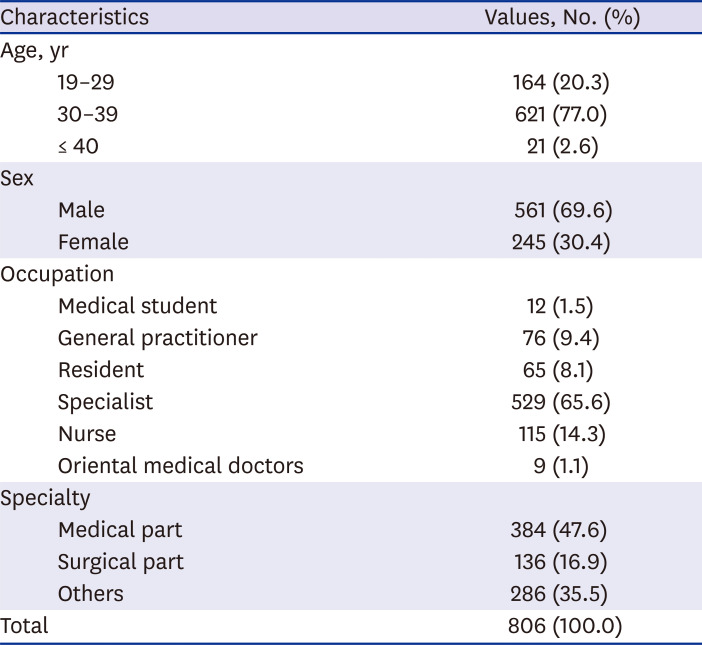

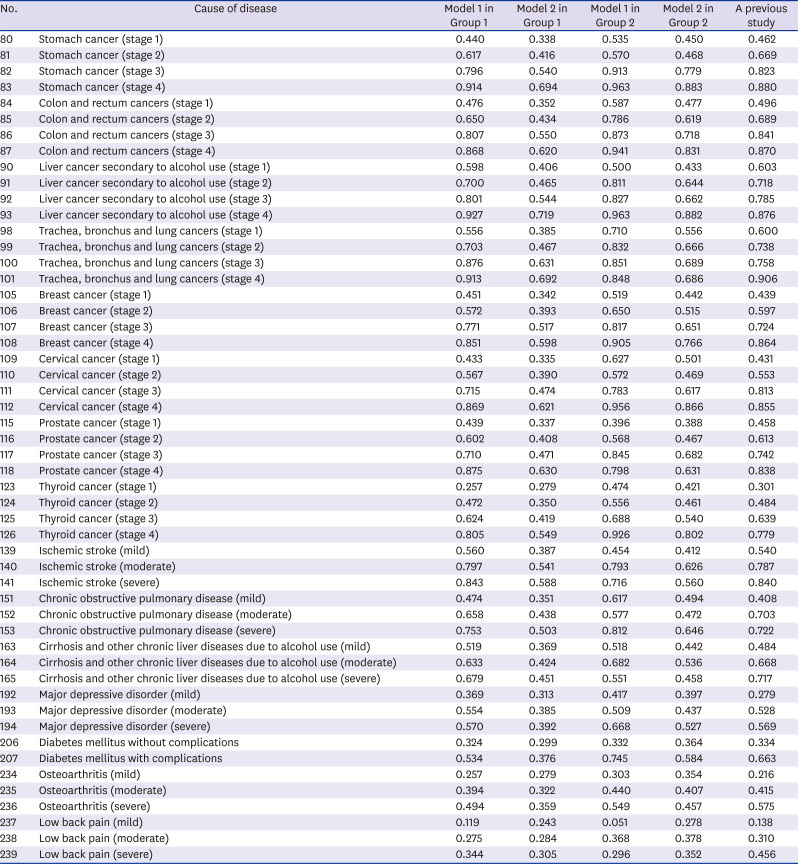
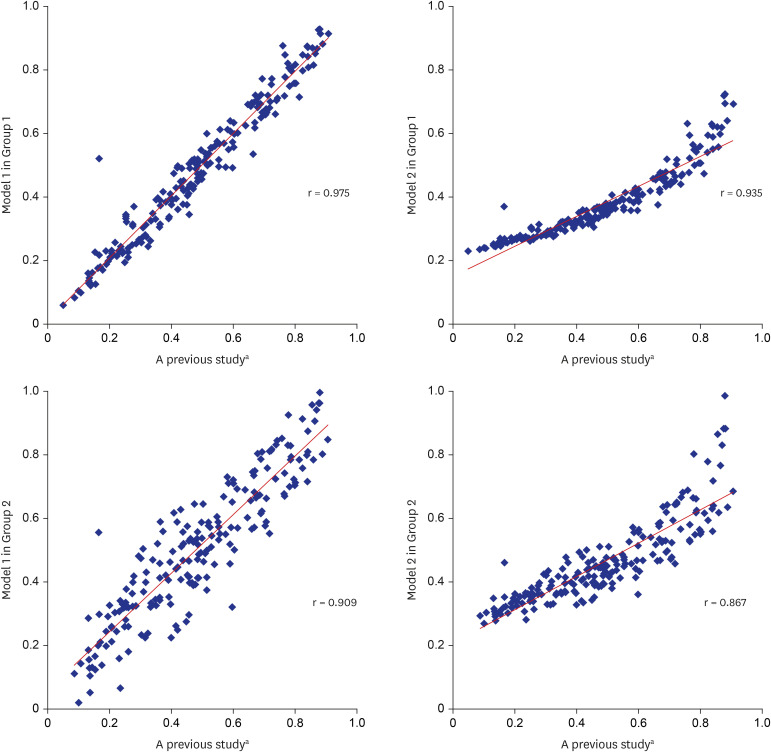




 PDF
PDF Citation
Citation Print
Print



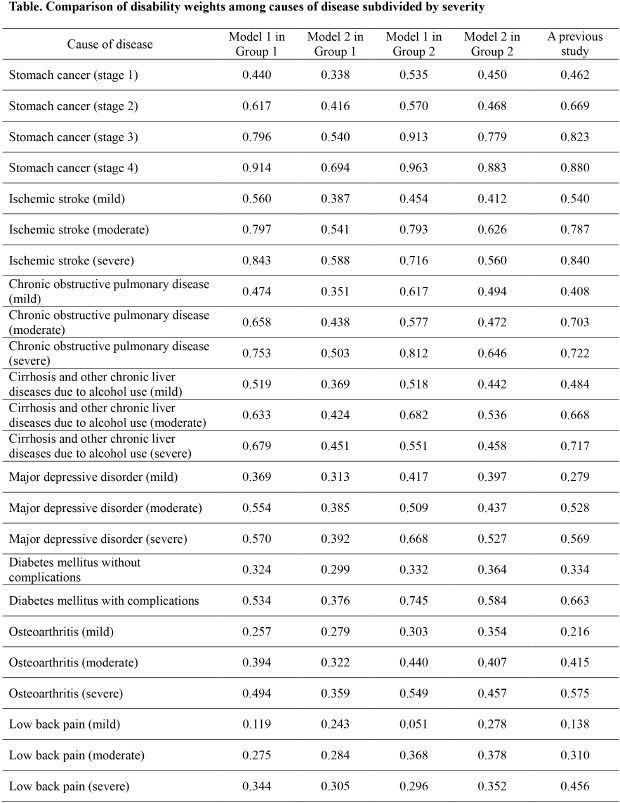
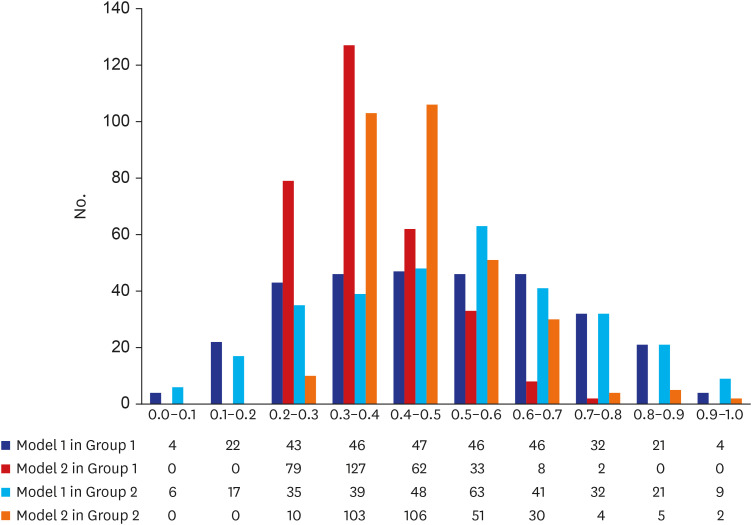
 XML Download
XML Download